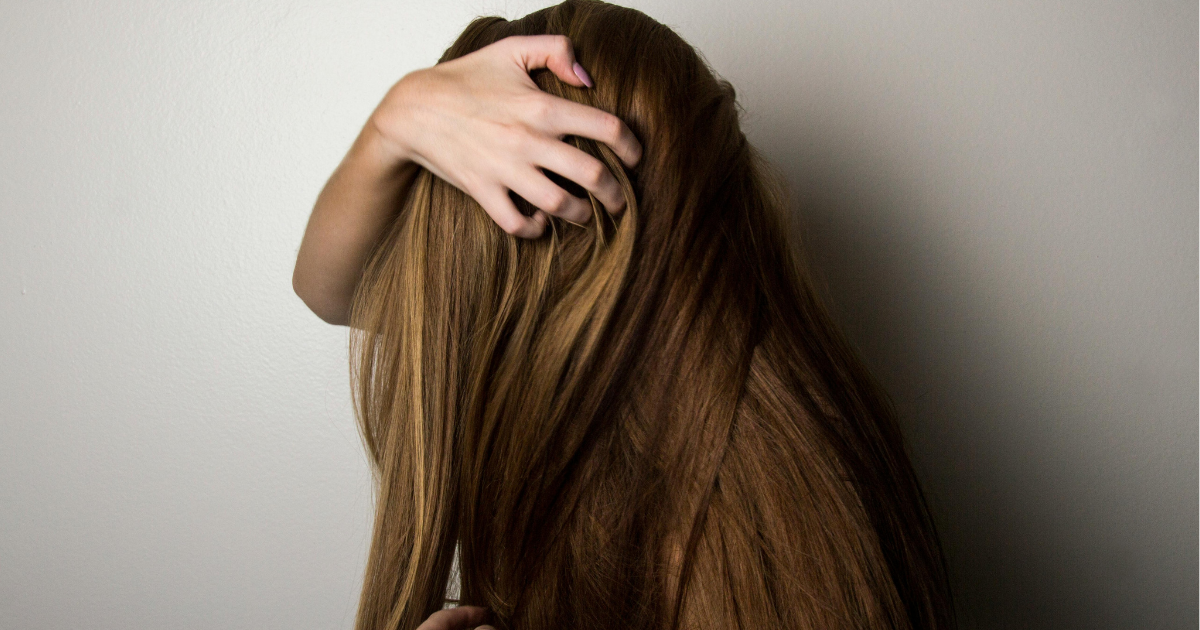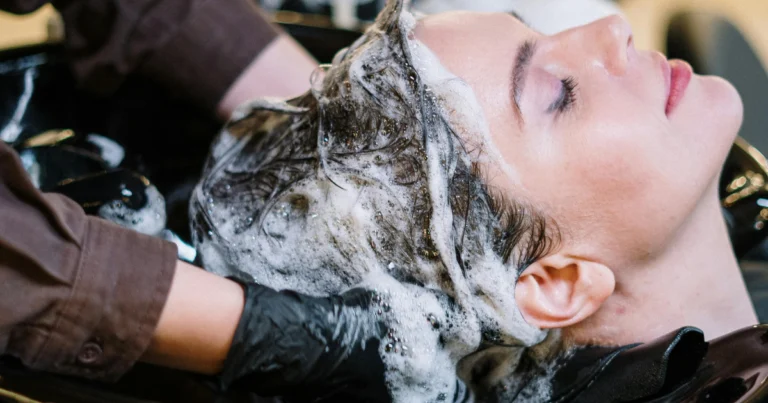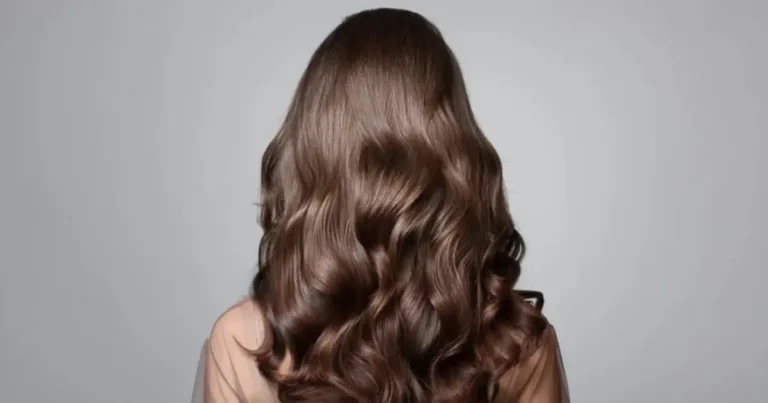Top 10 hair to care tips for stronger hair in 2025
Many people want strong, healthy hair, but it seems hard to achieve. In this guide, we’ll share ten key hair to care tips. These tips will help you keep your hair strong and full of life. You’ll learn how to understand your hair type and use natural treatments.
Table of Contents
Understanding Your Hair Type and Its Unique Needs
Knowing your hair type is the first step to better hair. Hair types range from straight and fine to coily and thick. Each type has its own needs and concerns.
Different Hair Types and Their Characteristics
Let’s look at the different hair types and what makes them unique:
- Straight hair is smooth and sleek but often lacks volume. It can get oily fast.
- Wavy hair has a gentle S-shape and can get frizzy and dry.
- Curly hair has a spiral pattern and can be dry and prone to breakage.
- Coily hair has a tight zig-zag pattern and is very fragile. It needs extra moisture and care.
Common Hair Concerns Based on Hair Type
Based on your hair type, you might face certain issues:
| Hair Type | Common Concerns |
|---|---|
| Straight | Oiliness, lack of volume, static electricity |
| Wavy | Frizz, dryness, unmanageable texture |
| Curly | Dryness, breakage, uneven curl pattern |
| Coily | Extreme dryness, brittleness, tangling |
Choosing Products for Your Specific Hair Type
Choosing the right haircare products is key. Look for products that match your hair type. For example, dry, curly hair needs a moisturizing shampoo. Fine, straight hair benefits from a volumizing conditioner.
By understanding your hair type and its needs, you can start a journey to healthier, more vibrant hair.
Essential Hair Washing Techniques and Best Practices
Proper hair washing techniques are key for healthy, vibrant shampoo, conditioner, and strong hair. By following these tips, your hair washing routine will effectively clean and nourish your hair.
Start by washing your hair with lukewarm water. Hot water can take away the natural oils, causing dryness and irritation. Gently massage your scalp with your fingertips to stimulate circulation and remove buildup.
- Apply a small amount of shampoo to your palms and work it through your hair, focusing on the roots. Avoid scrubbing too vigorously, as this can damage the cuticles.
- Rinse the shampoo thoroughly with lukewarm water, ensuring all traces are removed.
- Follow up with a conditioner applied from mid-length to the ends of your hair. Leave it in for a few minutes before rinsing.
- Avoid over-washing your hair, as this can lead to dryness and frizz. Aim for 2-3 washes per week, adjusting as needed based on your hair type and activity level.
The key to effective hair washing is to be gentle and patient. Rushing through the process or using excessively hot water can harm your hair. By following these best practices, you’ll have healthier, more manageable hair.
“The secret to beautiful, healthy hair lies in the way you wash it.”
Natural Treatments and Hair to Care Methods at Home
Natural treatments and DIY hair to care can make your hair strong and healthy. You can use homemade hair masks and kitchen ingredients to improve your hair to care. This way, you avoid harsh chemicals.
DIY Hair Masks and Their Benefits
Homemade hair masks deeply condition and revitalize your hair. Ingredients like avocado, honey, and coconut oil are great. They strengthen, hydrate, and protect your hair, making it soft and smooth.
Kitchen Ingredients for Hair Health
- Eggs: Rich in protein, eggs can help to fortify and strengthen hair strands.
- Olive oil: Packed with nourishing fatty acids, olive oil can deeply moisturize and add shine to your hair.
- Banana: The natural oils and vitamins in bananas can help to repair damaged hair and prevent breakage.
Weekly Hair To Care Routines
Having a weekly hair to care routine is key. Spend time each week on deep conditioning, clarifying shampoo, and hair treatments. This proactive approach leads to stronger, more vibrant hair.
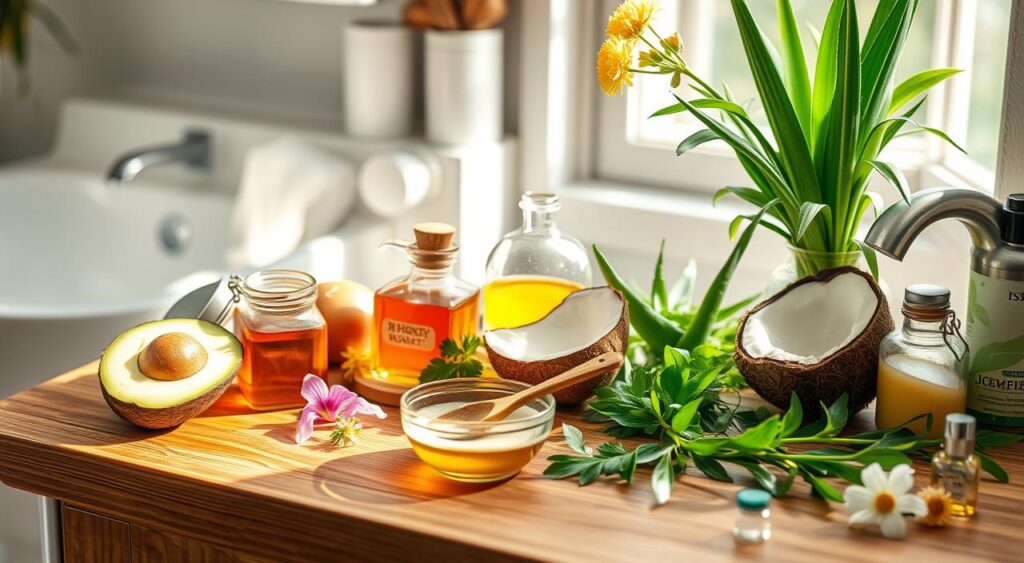
“Healthy hair starts from within. Nourishing your hair with natural, nutrient-rich ingredients can work wonders.”
Nutrition and Dietary Factors for Hair Growth
Eating a balanced diet is key for healthy hair. Vitamins, minerals, and fatty acids are important for hair health.
Biotin, or vitamin B7, is well-known for hair health. It strengthens hair follicles and boosts new hair growth. Find biotin in eggs, nuts, legumes, and whole grains.
Iron is also crucial for hair growth. It carries oxygen to hair follicles, helping them work well. Get iron from red meat, spinach, lentils, and fortified cereals.
Omega-3 fatty acids in salmon, walnuts, and flaxseeds also help hair. These fats reduce inflammation and aid hair growth.
Drinking enough water is also vital for hair. Dehydration makes hair dry and brittle, slowing growth. Drink at least 8 cups of water daily to keep your hair and body hydrated.
| Nutrient | Benefits for Hair | Food Sources |
|---|---|---|
| Biotin (Vitamin B7) | Strengthens hair follicles, stimulates growth | Eggs, nuts, legumes, whole grains |
| Iron | Transports oxygen to hair follicles | Red meat, spinach, lentils, fortified cereals |
| Omega-3 Fatty Acids | Reduces inflammation, promotes growth | Salmon, walnuts, flaxseeds |
Adding these nutrients to your diet supports hair health and growth. This makes your hair stronger, shinier, and more vibrant.
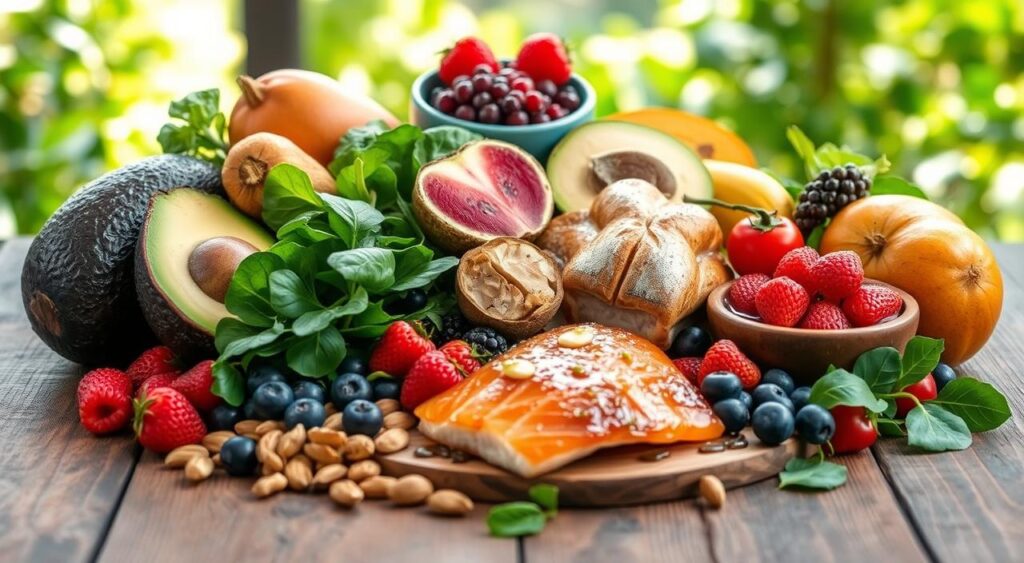
Protecting Your Hair from Environmental Damage
In today’s fast-paced world, our hair faces many environmental challenges. These can leave it vulnerable and damaged. From the scorching summer sun to the harsh winter winds, it’s crucial to understand how to safeguard your locks. This helps maintain their health and vitality.
Heat Styling Protection Methods
Heat styling tools like blow dryers, curling irons, and straighteners are essential for creating flawless hairstyles. However, they can also wreak havoc on your strands. To protect your hair from the damaging effects of heat, be sure to use a heat-protectant product before styling. These specialized formulas create a barrier that shields your hair from the intense temperatures. This prevents dryness, frizz, and breakage.
Seasonal Hair To Care Tips
- During the summer, use a sun-protecting spray or serum to shield your hair from the harsh UV rays. This can cause color fading and dryness.
- As the weather turns colder, switch to a nourishing, moisture-rich shampoo and conditioner. This helps combat the drying effects of winter winds and indoor heating.
- Incorporate a weekly deep-conditioning treatment into your routine. This replenishes lost hydration and keeps your hair strong and resilient.
Swimming and Sun Protection for Hair
Chlorine from swimming pools and the sun’s rays can be particularly damaging to your hair. Before diving in, apply a leave-in conditioner or oil to create a protective barrier. After swimming, rinse your hair thoroughly with fresh water to remove any chlorine or salt buildup. And don’t forget to wear a wide-brimmed hat or scarf when spending extended time in the sun. This shields your strands from UV exposure.
| Environmental Factor | Hair Protection Tip |
|---|---|
| Heat Styling | Use a heat-protectant product before styling |
| Summer Sun | Apply a sun-protecting spray or serum |
| Winter Weather | Use a nourishing, moisture-rich shampoo and conditioner |
| Swimming | Apply a leave-in conditioner or oil before swimming |
“Taking the time to protect your hair from environmental factors can make a significant difference in the long-term health and appearance of your locks.”
Conclusion
In this article, you’ve learned how to get stronger, healthier hair. You now know how to pick the right products and techniques for your hair type. This knowledge helps you make better choices for your hair.
Washing your hair regularly and using natural treatments can make it healthier. Eating right and protecting your hair from the environment are also key. These steps help keep your hair healthy for a long time.
Healthy, vibrant hair comes from consistent care and a complete approach. Use the tips from this article to get the hair you’ve always wanted. Your journey to better hair health, care, and maintenance begins now.
FAQ
What are the different hair types and their characteristics?
Hair types vary, each with its own look. Straight hair is smooth and sleek. Wavy hair has a gentle wave. Curly hair forms ringlets, and coily hair is tightly coiled. Knowing your hair type helps you tackle specific hair issues.
How often should I wash my hair?
Washing frequency depends on your hair type. Fine, oily hair might need daily washing. Coarse, dry hair might only need washing a few times a week. Finding the right washing schedule is key for hair and scalp health.
What are some natural hair treatments I can do at home?
DIY hair masks and treatments are easy to make. Avocado and honey masks hydrate. Coconut oil nourishes, and apple cider vinegar clarifies. Adding these to your routine can strengthen and condition your hair.
How can I protect my hair from heat damage and environmental factors?
Protect your hair from heat and the environment. Use a heat protectant spray before styling. Wear hats or scarves in the sun. Use leave-in conditioners or hair masks to nourish. Limit heat and add moisture to prevent damage.
What nutrients are important for hair growth and health?
Certain nutrients are vital for hair health. Biotin, iron, omega-3s, and protein are key. Eating foods like eggs, spinach, salmon, and nuts can nourish your hair from the inside.

